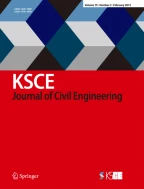Abstract
Crack prevention is a significant issue in the construction process of concrete dams. The vast majority of concrete cracks are related to temperature variations, and hence, temperature control is a primary method used to prevent cracks. This paper presents a new integrated concept, named Feedback Design (FD) of temperature control measures, which incorporates real-time temperature monitoring, temperature field simulation and construction process simulation in a large system to optimize a temperature control scheme for concrete dams. We used a fiber-optic Distributed Temperature Sensing (DTS) system to monitor the temperature variation process of typical dam monoliths in real time. By incorporating a genetic algorithm, neural network algorithm, and finite element theory, we proposed an intelligent inversion method to obtain thermal parameters of concrete dams based on the temperature monitoring data. Meanwhile, we built a simulation model of a concrete dam’s construction process based on a cycling network technique to obtain accurate construction environmental parameters. Finally, we simulated the temperature field of a typical dam monolith based on initial temperature control measures, inversion thermal parameters, and accurate construction environmental parameters. Temperature variance lines of typical points in the model obtained from the finite element method (FEM) accord well with the measured values obtained from the DTS system. We applied the FD approach to the Xiluodu arch dam located in southwest China to forecast the temperature fields and optimize the temperature control scheme of the dam blocks planned for pouring. The FD approach has been proven reliable and efficacious.
Similar content being viewed by others
References
Banerjee, A., Paul, D. K., and Acharyya, A. (2015). “Optimization and safety evaluation of concrete gravity dam section.” KSCE J. Civ. Eng., Vol. 19, No. 6, pp. 1612–1619, DOI: 10.1007/s12205-015-0139-0.
Cao, F. J., Fang, G. H., Ma, X. G., and Hu, Z. N. (2012). “Simulation analysis of crack cause of concrete overflow dam for Hadashan Hydro Project by 3-D FEM.”, Systems Engineering Procedia, Vol. 3, pp. 48–54, DOI: 10.1016/j.sepro.2011.11.007.
Chen, Y., Zhang, L., Chen, J. Y., Li, C. G., and Hu, C. Q. (2011). “Cracking similarity simulation of induced joints and its application in model test of a RCC arch dam.” KSCE J. Civ. Eng., Vol. 15, No. 2, pp. 327- 335, DOI: 10.1007/s12205-011-0969-3.
de Araújo, J. M. and Awruch, A. M. (1998). “Cracking safety evaluation on gravity concrete dams during the construction phase.” Computers & structures, Vol. 66, No. 1, pp. 93–104.
de Jong, S. A. P., Slingerland, J. D., and van de Giesen, N. C. (2015). “Fiber optic distrib-uted temperature sensing for the determination of air temperature.” Atmos. Meas. Tech., Vol. 8, No. 1, pp. 335–339, DOI: 10.5194/amt-8-335-2015.
Fu, S. J., He, T., Wang, G. J., Zhang, S. H., Zou, L. C., and Chen, S. H. (2011). “Evaluation of cracking potential for concrete arch dam based on simulation feedback analysis.” Sci. China Technol. Sci., Vol. 54, No. 3, pp. 565–572, DOI: 10.1007/s11431-010-4274-z.
Guan, J. F., Qing, L. B., Bai, W. F., Wang, J., and Lin, P. (2013). “Engineering Advice for Preventing Crack on the Upstream Surface of Super- High Arch Dam.” Applied Mechanics and Materials, Vol. 438–439, pp. 1320–1324, DOI: 10.4028/www.scientific.net/AMM.438-439.1320.
Ha, J. H., Jung, Y. S., Cho, Y. G. (2014). “Thermal crack control in mass concrete structure using an automated curing system.” Automat. Constr., Vol. 45, pp. 16–24, DOI: 10.1016/j.autcon.2014.04.014.
Hamderi, M., Guler, E., and Raouf, A. (2017). “An investigation on the formation of cracks at the corner turns of the modular block earth walls.” Int. J. Civ. Eng., pp. 1–12, DOI: 10.1007/s40999-017-0216-5.
Lin, P., Liu, H. Y., Li, Q. B., and Hu, H. (2014). “Effects of outlets on cracking risk and integral stability of super-high arch dams.” The Scientific World Journal, Vol. 2014, pp. 1–19, DOI: 10.1155/2014/ 312827.
Liu, X. H., Duan, Y., Zhou, W., and Chang, X. L. (2015). “Modeling the piped water cooling of a concrete dam using the heat-fluid coupling method.” J. Eng. Mech., Vol. 139, No. 9, pp. 1278–1289, DOI: 10.1061/(ASCE)EM.1943-7889.0000532.
Maken, D. D., Léger, P., and Roth, S. N. (2014). “Seasonal thermal cracking of concrete dams in northern regions.” J. Perform. Constr. Facil., Vol. 28, No. 4, pp. 4014014, DOI: 10.1061/(ASCE)CF.1943- 5509.0000483.
Ren, H., Li, T. C., Chen, H. F., and Zhao, L. H. (2008). “Nonlinear simulation of arch dam cracking with mixed finite element method” Water Science and Engineering, Vol. 1, No. 2, pp. 88–101, DOI: 10.3882/j.issn.1674-2370.2008.02.009.
Su, H. Z., Li, J. Y., and Wen, Z. P. (2014). “Evaluation of various temperature control schemes for crack prevention in RCC arch dams during construction.” Arab. J. Sci. Eng., Vol. 39, No. 5, pp. 3559–3569, DOI: 10.1007/s13369-014-1010-1.
Wu, B. B., Wu, Z. R., Chen B., Su H. Z., Bao, T. F., and Wang, S. W. (2016). “Crack status analysis for concrete dams based on measured entropy.” Sci. China Technol. Sci., Vol. 59, No. 5, pp. 777–782, DOI: 10.1007/s11431-016-6018-1.
Zhu, B. F. (2006). “Current situation and prospect of temperature control and cracking prevention technology for concrete dam.” Journal of Hydraulic Engineering, Vol. 37, No. 12, pp. 1424–1432. (in Chinese)
Zhu, B. F. (2012). “Thermal stresses and temperature control of mass concrete.” China WaterPower Press, Beijing, China. (in Chinese)
Zhu, B. F. (2015). “Discussion on the causes of crack formation during construction of Xiaowan Arch Dams.” Water Resources and Hydropower Engineering, Vol. 46, No. 4, pp. 1–5. (in Chinese)
Author information
Authors and Affiliations
Corresponding author
Rights and permissions
About this article
Cite this article
Zhou, H., Zhou, Y., Zhao, C. et al. Feedback Design of Temperature Control Measures for Concrete Dams based on Real-Time Temperature Monitoring and Construction Process Simulation. KSCE J Civ Eng 22, 1584–1592 (2018). https://doi.org/10.1007/s12205-017-1935-5
Received:
Revised:
Accepted:
Published:
Issue Date:
DOI: https://doi.org/10.1007/s12205-017-1935-5
